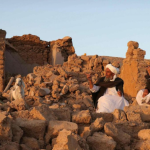A strong earthquake in western Afghanistan, close to the border with Iran, is thought to have killed hundreds of people.
Some figures say that a lot more people died. The 6.3-magnitude earthquake on Saturday destroyed at least 12 towns close to the city of Herat.
There were strong tremors afterward. People who lived talked about how scared they were as buildings fell around them.
Rescuers worked all night to try to find people who were stuck under the rubble.
A huge number of people have been hurt.
In a place with very few medical facilities, hospitals are having a hard time taking care of people who are hurt. The UN and other organizations are rushing in emergency supplies.
Around 11:00 local time (06:30 GMT) on Saturday, the earthquake happened about 40 km (25 miles) northwest of Herat.
“All of a sudden, the building started shaking while we were in our offices.” The wall plaster began to fall off, and the walls began to crack. Some walls and parts of the building fell down. Bashir Ahmad, who lives in Herat, told the AFP news agency.
“I can’t get in touch with my family… It was pretty scary, and I’m too worried and scared to say anything else.
The Taliban’s minister of public health is going to Herat to figure out how bad the effects are.
After the Saturday earthquake in Herat, many people left their homes.
Video from Herat Central Hospital showed people with intravenous drips being handled outside of the main building. This shows how quickly and heavily people needed emergency care.
Other images depict the devastation in Herat’s Injil region, where debris blocked roads and made it more difficult to rescue people.
Student Idrees Arsala told AFP, “The situation was very bad; I have never been through anything like that before.” After the quakes started, he was the last person to leave his classroom safely.
Herat is 120 km (75 miles) east of the border with Iran. It is known as the culture capital of Afghanistan. It is thought that about 1.9 million people live in the province.
Afghanistan has a lot of earthquakes, especially in the Hindu Kush Mountain area, which is close to where the Eurasian and Indian tectonic plates meet.
A 5.9-magnitude earthquake hit the province of Paktika in June of last year. It killed over 1,000 people and left tens of thousands without homes.















